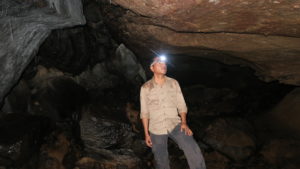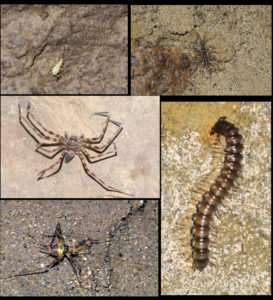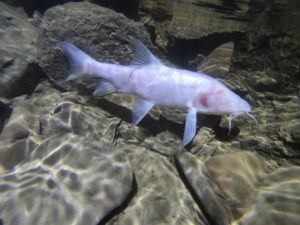By Uttam Saikia and Brian D. Kharpran Daly

Meghalaya is one of the smaller states in India, yet it harbours nature’s plentiful bounties. The region has a rich and deep geological history that continues to marvel researchers and citizens. The state possesses the richest karst landscape in the Indian subcontinent which is a topography arising out of the dissolution of soluble rocks such as limestones by the action of ground or surface water. Karst areas are characterised by subterranean drainage systems with caves and sinkholes. So far, cave experts from India and abroad have recorded around 1700 caves from the state of which over 1000 have been explored or partially explored/mapped. Although most of the caves in Meghalaya are formed by the force of water on limestone deposits (which are plentiful in the state), there are some caves that are of sandstone origins. For example, the recently discovered Krem Puri (Krem means cave in the local Khasi dialect), with a surveyed length of 25.37 km is considered the longest sandstone cave in the world. To add to the geological distinctions of the state, the International Commission on Stratigraphy has recently recognised the current geologic age as the “Meghalayan Age”, the period of which has been pegged to start from 4200 years ago to the present. The recognition of the “Meghalayan Age” is based on some geochemical signatures deciphered from a piece of stalagmite recovered from Mawmluh cave near Sohra in the state. The credit for explorations of the cave systems of Meghalaya goes to a team of multinational cave explorers. These cavers along with their local partner Meghalaya Adventurers’ Association led by Brian Kharpran Daly have been exploring Meghalayan caves for over three decades under the project “Caving in the Abode of the Clouds” leading to stupendous discoveries. These expeditions have also been successful in the occasional discovery of interesting animals including the world’s largest cave fish Neolissochilus pnar discovered from Krem Um Ladaw and Krem Rynjang in East Jaintia Hills. Scientists of the Zoological Survey of India, Shillong are also currently occupied with documenting the cave fauna of a select few caves in the state. However, a detailed faunal inventory of the caves in Meghalaya is largely lacking except for the century-old meticulous exploration of Siju Dobakhol in Garo Hills by Kemp and Chopra of the Calcutta Museum, now known as Zoological Survey of India. This particular exploration of cave faunal diversity continues to be the most comprehensive study in India to date and has resulted in the documentation of over 100 animal species including many new species.
The cave environment
Caves are large natural openings or voids in the ground that extend beyond the zone of light. Most of the caves in Meghalaya extend well beyond the zone of light, with penetrations running into kilometres, and are perpetually in absolute darkness. Since there is no sunlight, there is little source of energy for organisms to sustain themselves and therefore cave systems are energy-depleted ecosystems. The primary source of energy in cave systems is detritus material flushed in by running water as well as other waste materials generated by some of the inhabitants. For example, most of the Meghalaya caves harbour bats, and sometimes large colonies can be found there. The excreta of these bats, deposited on the cave floors, is rich in nutrients and organic matter and thus a significant source of energy. The microclimate inside a cave is also relatively stable throughout the year which is why some mammals, especially bats, are attracted to caves for roosting and rearing young ones.

A living world underneath
It is often hard to imagine a living world thriving underneath the earth’s surface, but it does exist! A diverse, albeit specialised group of animals have been able to live and thrive in these caves, with and without water running through them. These cave-dwelling animals are collectively known as Troglofauna (Greek Trolge meaning hole). A wide variety of animals from invertebrates to higher mammals use the cave environment for feeding, producing young ones, and taking shelter. However, not all of these animals can be termed as true cave animals as some of them utilise caves for their own benefit for some stages of their life cycle but can also survive outside caves. Based on the level of dependency on the cave environment, cave animals are broadly classified into three groups. Trogloxenes are animals that use the cave environment for certain seasons or purposes. For example, bats in temperate regions may use caves for winter sleep or for communal rearing of young ones, but at other times they may not be dependent on caves for roosting. Troglophiles are another group of animals that can live outside the cave environment but normally prefer to live inside caves. Several species of frogs, salamanders, spiders, and crayfish are known to live in caves but occasionally leave the cave for foraging. These two groups of cave-dwelling animals do not exhibit any particular morphological or physiological adaptations suitable for caves. The true cave-adapted animals are known as Troglobites and they cannot survive outside the cave environment. As mentioned before, the cave environment is unique, without light and very little energy source and therefore, this group of animals has developed special adaptations for surviving in such an environment. Poorly developed eyes or entire loss of the eyes is one such adaptation. In a dark environment, there is no utility of eyes, besides it requires a significant amount of energy to maintain an organ which would be redundant in such dark confines. Besides, most of the true cave-adapted animals lose their skin pigmentation which is primarily designed to protect the animal from harmful UV rays. Consequently, they appear white or translucent. To compensate for the poor development or loss of eyes, other sensory faculties are better developed. For example, in some cave arthropods, the antennae are highly developed and act as organs of smell or touch. Besides, since food sources in caves are distributed thinly and widely, cave animals need to travel a great distance for foraging which results in the development of longer and stronger legs. Many cave arthropods like crickets exemplify this adaptation.
Bats as keystone species in caves
As mentioned, bats are not true cave animals as they are not entirely dependent on caves. However, in cave-rich regions, most of the bat species are known to be associated with caves. It has been reported that an overwhelming percentage of bat species reported from China roost in caves or similar subterranean habitats. Bats are found in most of the caves in Meghalaya and are numerically the most abundant group of cave mammals. More than half of the reported bat species in Meghalaya are known to roost in caves, at least temporarily. Large bat colonies are known from several caves in Meghalaya and some of the global data-deficient and rare bats are also known from there. Leaving aside number and diversity, bats are considered keystone species in the cave ecosystem as their guano is a major source of energy in caves supporting a large assemblage of cave fauna. Although the diet of bats varies with species, generally bat guano is rich in nutrients and organic matter and therefore provides the primary organic input to cave systems. Bat guano is accumulated in the cave floors where a diverse group of guano-loving arthropods thrive. Besides, many fungi and bacteria also grow on bat guano which is also eaten by beetles or mites. These in turn serve as prey for cave-dwelling fish or crayfish.

The state of Meghalaya holds half of the reported bat species in India, an astonishing feat for such a small geographic area. The presence of a large number of caves and caverns is cited as one of the primary reasons for this extraordinary diversity as more than one-third of the bat species occurring in the state roost only in caves. Some of the noteworthy species that inhabit the caves in the state include highly protected and elusive Wroughton’s free-tailed bat and the state holds more than half of the known global population of this bat. In India, bat species like Rickett’s big-footed Myotis, Great evening bat, Szechwan Myotis, Khasi leaf-nosed bat, are some that are known to be found only in the caves of Meghalaya. In fact, a number of rodents and carnivores have also been reported from Meghalaya’s caves including some possible accidental introduction. Therefore, caves present a good opportunity for the conservation of such lesser-known fauna.
Meghalaya’s cave systems are in real danger
A vast majority of the caves in Meghalaya are located in the limestone belt situated in the southern periphery and extending East to West for about 200 kms. Similarly, Meghalaya also holds substantial deposits of coal which are again distributed in the southern part of the Shillong plateau. Therefore, large-scale coal and limestone mining occurs in the region dotted with caves. Although mining is an important source of revenue for the state exchequer and brings some economic relief to the local populace, the mining techniques used are unscientific (rat hole mining), unregulated, and not ecologically sustainable. Due to large-scale mineral mining, the ecology of many of the areas in the Khasi and Jaintia Hills are irreparably damaged. Many rivers in the region have become highly polluted from acid mine discharge. The river Lukha which runs near the boundary of Narpuh Wildlife Sanctuary has been extensively polluted from acid mine discharge and release of effluents from cement factories in the catchment area. It is well known that the cave environment is very fragile and susceptible to human and external disturbances. There are several instances where cave systems were partially or completely damaged by mining activities. For example, Krem Umlawan, part of Umlawan-Kotsati cave system in East Jaintia Hills has completely lost its original biota because of sludge deposits from limestone mining in nearby areas. Similarly, “Meghalayan Age” famed Krem Mawmluh which is also a UNESCO geological heritage site had a portion of the cave ceiling collapsed due to limestone mining over the cave, as also the complete obliteration of Krem Um Kseh. Theoretically, each cave system with its biota is potentially unique. The recent discoveries of a few unique cave-dwelling fish species from these caves only underscore this fact. A complete ban on mining in the state like one imposed by the National Green Tribunal in 2014 is not a pragmatic solution to this issue as it deprives the state of some much-needed revenue. However, the government too, must be mindful of mining activities in the state and efforts must be made to have them controlled, scientifically and ecologically, to avoid detrimental effects on the environment. It is also an urgent task that the caves of Meghalaya with high geological and biological value should be prioritized for conservation and no mining activities should be permitted in their vicinity. However, this is a daunting task given the lack of demanding scientific and financial resources to undertake such a prioritisation exercise. The system of land tenure and land ownership in Meghalaya is complex and most of these mines are located in private land without much government control. Therefore, it is also essential for the custodians of the land to look beyond short-term economic benefits from unregulated mineral extractions which also damage the local ecology irreparably. Any amount of justification will not suffice if the land and water we inherited from our ancestors becomes barren and inhospitable because of our actions.
Caves and their biota are the unique product of the long geologic and evolutionary history of Earth and a priceless heritage everybody should be proud of and endeavour to protect.
About the authors: Dr. Uttam Saikia is a senior scientist at Zoological Survey of India, Shillong. Brian K. Daly is the General Secretary of Shillong based Meghalaya Adventurers Association and a well known caver.



